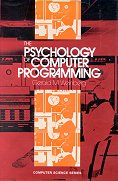
Gerald M. Weinberg.
The Psychology of Computer Programming.
Van Nostrand Reinhold. 1971
rating : 2 : great stuff
This is Weinberg's introduction to General Systems Theory (reprinted 25 years after its original 1975 publication): a way of looking at, modelling, and understanding a complicated, complex world. This approach was deeply tied up with the cybernetics movement, which is currently reincarnating parts of itself as the complex-adaptive systems movement. It is worthwhile to learn as much from history as possible (something that often escapes many computer scientists, who seem to feel that the subject has no history), so I am going back and reading some of that movement's literature.
Weinberg goes through the principles, with a bunch of simple but illustrative examples, and some pertinent anecdotes. In the preface, he gives some quotations from extremely satisfied customers, countered by one from a computer programmer who says "I didn't learn anything ... It was a bunch of platitudes". I wouldn't go quite that far, but there was certainly nothing paradigm-shifting for me: the general computational modelling world has moved on in 25 years. However, I can see that for those who haven't already had a modelling-intensive education, there could be a lot of good stuff here.
It is most interesting in its final chapter, when it starts talking about taking a more process-oriented (as opposed to thing-oriented) view of the world, and references a book to come. I would like to read that book -- I don't think Weinberg got round to writing it.
Using memorable rules, laws, and principles to make his points, Gerald M. Weinberg offers wise and witty advice on how to succeed in this highly competitive profession. Among the topics are pricing and marketing your services, measuring your effectiveness, and dealing with client resistance.
This is a thoughtful and highly individualistic account of the art of influencing people at their request. (The reader is assumed to have made such a request, by virtue of the act of reading the book.) It covers a range of issues, including how to get information out of people, advice on running meetings, how to make the client not feel a failure for having to ask for advice, why solving the problem isn’t always the best idea, how to get people to take the advice they’ve paid for, how to get them to not need the same advice again, why not to get angry if someone steals your ideas, and how to set a fee rate. All this sound and pragmatic advice is illustrated with vivid little scenarios and anecdotes, from The Orange Juice Test, to the Principle of Least Regret, that should stick in the mind long after the book has gone back up on the shelf.
Every consultant, and everyone who hires a consultant, should read this.
The book is not intended as an alternative to structured analysis and design, but rather as a supplement for those who must deal with the less structured processes of analysis and design. Its seven parts explore both the logical as well as the more intuitive aspects of the analysis/design process, and they each conclude with a witty and illustrative fable. As Weinberg writes in the Preface, this book should “help you become a more complete analyst or designer.”
Gerald M. Weinberg—author of more than forty books and more than 400 articles over a forty-year career—reveals his secrets for gathering, organizing, and discarding writing ideas.
Drawing an analogy to the stone-by-stone method of building fieldstone walls, Weinberg shows writers how to construct fiction and nonfiction manuscripts from key insights, stories, and quotes. The elements, or stones, are collected nonsequentially, over time, and eventually find logical places in larger pieces.
The method renders writer’s block irrelevant and has proved effective for scores of Weinberg’s writing class students, who have collectively published more than 100 books. If you’ve ever wanted to write a book or article—or need a fresh approach to your writing career—try what works for Weinberg and gather your best ideas into beautiful stone walls.
In this slim book, Weinberg delivers his advice to aspiring technical writers, based on the metaphor of building a dry stone wall from “fieldstones”:
The fieldstone method is a pragmatic process for writing: you are doing it all the time, from gathering small snippets, to writing entire books. It won’t work for those times when you just have to write on a topic that you are not passionate about. Weinberg is privileged enough that this has not been a problem for him: he “cheated” at college to be allowed to write on his own topics, then in industry he was lucky enough that his boss took his first somewhat off topic report seriously, and now as a consultant he can write what pleases him. However, even in a non-voluntary scenario, if you have the stones, you can probably pull off an acceptable piece of work using this approach.
On the terrified campus of Hurlesburg U., Mathematics Professor and former NSA problem-solver Josh Rosemont, finds a young woman’s body in the woods. He is paralyzed by her resemblance to his murdered daughter. As the murders continue, he is enraged into action by an obstructive Dean. Teaming with his cop-turned-anthropologist wife, Carmela, and his four genius grad students, he sets out to prevent another murder.
Blending every skill and trick of their professions, Rosy’s team hounds a twisted trail of false clues to uncloak the Dean’s sex scandal, decipher incriminating evidence in a billion-dollar swindle, and thwart the serial killer—a deranged student who believes raping and killing a potential suicide is not really murder.
But did they catch the real killer?